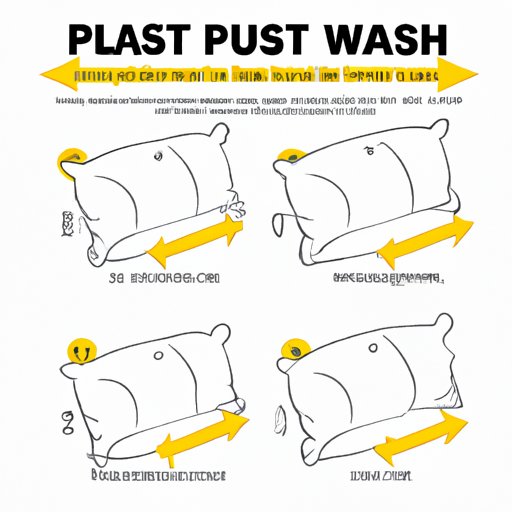
I. Introduction
Dirty pillows can cause a range of problems, from poor sleep quality to health concerns. However, many people overlook the importance of washing their pillows regularly. This article will provide a comprehensive guide on how to wash your pillow, covering everything from step-by-step instructions to common mistakes to avoid.
II. Step-by-step Guide: How to Wash a Pillow
Washing your pillow regularly can improve its lifespan, smell, and overall quality. Here’s a step-by-step guide on how to properly wash your pillow:
- Remove the pillowcase and protector, if applicable.
- Check the pillow label for any specific washing instructions or recommendations.
- Pre-treat any stains or soiled areas with a laundry stain remover.
- Place the pillow in the washing machine with mild detergent and run on a gentle cycle with warm water.
- Run an extra rinse cycle to ensure all soap residue is removed.
- Place the pillow in the dryer on a low heat setting, adding a few dryer balls or clean tennis balls to help fluff the pillow. Stop the dryer periodically to fluff the pillow by hand.
- Once the pillow is dry, fluff it to redistribute the filling.
It’s important to note that not all pillows can be washed and dried according to these instructions. Keep reading to learn how to wash different types of pillows properly.
III. Video Tutorial: How to Wash a Pillow
While the step-by-step guide is helpful, sometimes visual demonstrations can make things easier to understand. Here’s a video tutorial that walks you through the process of washing your pillow:
https://www.youtube.com/watch?v=3YzJGD5QlK0
The voice-over provides clear instructions for each step, so you don’t have to worry about missing anything.
IV. Different Types of Pillows and How to Wash Them
It’s important to understand that different types of pillows require different washing methods to ensure they maintain their quality and shape. Here are some specific instructions for washing different types of pillows:
- Down pillows: Wash in a front-loading washing machine with mild detergent and tumble dry on low heat with clean tennis balls.
- Memory foam pillows: Hand wash with mild detergent and cold water. Air dry, avoiding direct sunlight.
- Polyester pillows: Wash in a washing machine with mild detergent and tumble dry on low heat with clean tennis balls.
- Latex pillows: Wipe clean with a damp cloth or mild soap and warm water. Avoid using a washing machine or dryer.
It’s always best to check the label of your pillow before washing and follow any specific instructions or recommendations.
V. DIY Pillow Washing Solution
While store-bought detergents can be effective, some people prefer to use natural solutions for washing their pillows. Here’s a recipe for a DIY pillow washing solution using vinegar:
- 1 cup of white vinegar
- 1/2 cup of baking soda
- 1/2 cup of laundry detergent
Here’s how to use the solution:
- Combine all ingredients in a large bowl.
- Pour the solution into the washing machine.
- Wash the pillow according to the step-by-step guide above.
It’s important to note that vinegar can be a strong scent, so you may want to toss a few dryer sheets in with the pillow during the drying process to help mask the smell. Also, avoid using vinegar on certain materials, such as silk or wool.
VI. Professional Cleaning Options for Pillows
While washing your pillow at home is an effective way to keep it clean, some people prefer to use professional cleaning services. Here are some professional cleaning options for your pillows:
- Dry cleaning: This method uses special solvents to clean the pillow and is typically safe for most types of pillows.
- Professional washing services: These services offer specialized cleaning methods, such as UV sanitation, to eliminate bacteria and allergens.
When choosing a professional cleaning option, consider the cost and the potential impact on the environment. Additionally, make sure to check with the cleaning service to ensure they can safely clean your specific type of pillow.
VII. Common Mistakes to Avoid When Washing Pillows
Washing your pillow is a simple process, but there are a few common mistakes that people make. Here are some tips to avoid those mistakes:
- Using too much detergent: Excess detergent can leave residue on the pillow and cause skin irritation. Use only the recommended amount.
- Overloading the washing machine: Too many pillows in the washing machine can prevent them from being cleaned properly. Wash no more than two pillows at a time.
- Using hot water: Hot water can cause the pillow to lose its shape and may damage certain materials. Use warm or cool water instead.
- Not drying the pillow completely: Moisture left in the pillow can lead to mold and mildew growth. Make sure the pillow is completely dry before using it again.
VIII. Pillow Care Tips
Proper pillow care can extend its lifespan and maintain its quality. Here are some tips to keep in mind:
- Wash pillows every six months: Regular washing can eliminate bacteria and allergens that can affect your sleep quality and health.
- Replace pillows every two years: Over time, pillows lose their fluffiness and support, leading to poor sleep quality and neck pain. Replace every two years for optimal results.
- Store pillows properly: Store pillows in a dry, cool place to prevent moisture buildup and mold growth. Avoid storing them in plastic bags or containers, as this can trap moisture.
IX. Conclusion
Washing your pillow regularly is an important step in maintaining your sleep quality and overall health. Whether you choose to wash your pillow at home or use professional services, following the steps outlined in this article will ensure you achieve optimal results. Don’t forget to take care of your pillow by replacing it every two years and storing it properly for ultimate comfort and support.




